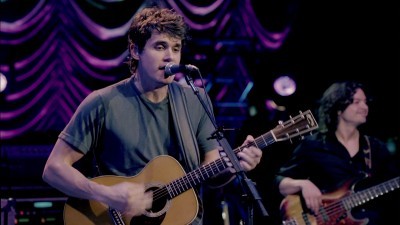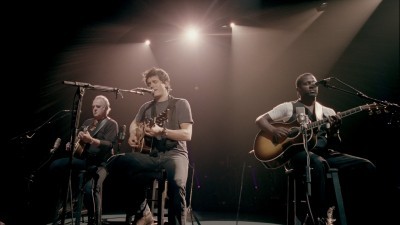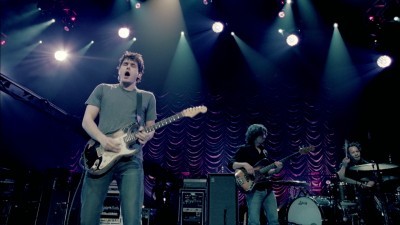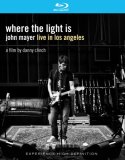| Reviews & Columns |
|
Reviews DVD TV on DVD Blu-ray 4K UHD International DVDs In Theaters Reviews by Studio Video Games Features Collector Series DVDs Easter Egg Database Interviews DVD Talk Radio Feature Articles Columns Anime Talk DVD Savant Horror DVDs The M.O.D. Squad Art House HD Talk Silent DVD
|
DVD Talk Forum |
|
|
| Resources |
|
DVD Price Search Customer Service #'s RCE Info Links |
|
Columns
|
|
|
John Mayer: Where the Light Is
Sony Pictures // Unrated // July 1, 2008 // Region 0
List Price: $29.98 [Buy now and save at Amazon]
While my taste in music admittedly leans more towards sugary power-pop than blues-inflected rock or soulful acoustic numbers, it's impossible not to marvel at John Mayer's immense talent. His virtuosity on the guitar defines Where the Light Is, a document of a charity concert filmed in Los Angeles last November. In the same way that Mayer has shrugged off the sensitive singer/songwriter label and started to explore more mature, more blues-oriented musical territory, Where the Light Is also veers away from the usual expectations for this sort of concert film. For one, director Danny Clinch opted to shoot the concert on 35mm film, a stylistic choice that's rarely seen in this day and age. Rather than play as a "greatest hits, live" show, Mayer largely shies away from his older material, passing on playing early hits like "No Such Thing" and "Your Body Is a Wonderland". Only two songs -- "Why Georgia" and
"Neon" -- overlap with Mayer's previous concert DVD, and the bulk of the setlist is culled from 2006's "Continuum" and the John Mayer Trio's live album.
Even the concert itself is uniquely structured. Mayer essentially opens for himself -- twice, no less -- in this series of three separate sets. Where the Light Is opens with three solo acoustic numbers, with more guitarists joining Mayer on-stage for performances of "Daughters" and a low-key cover of Tom Petty's "Free Fallin'". The second set features the reunion of the John Mayer Trio, a blues project backed by the rhythm section of legendary studio musicians Steve Jordan and Pino Palladino. This incendiary stretch of the show includes a couple of slower blues grooves like "Out of My Mind" and "Come When I Call" alongside barnstormers like a cover of Jimi Hendrix' "Wait Until Tomorrow". Where the Light Is closes out with a performance by Mayer's full band, including keys, horns, and, by the end, even a couple of bassists thumping away on-stage.
Every few songs, Where the Light Is cuts away from the stage. These interstitials include Mayer talking to the camera as he drives to rehearsal, changes into a full suit and tie for his set with the John Mayer Trio, and improvises a quick song about a dumpy paparazzo who starts trailing him. These snippets are short and infrequent enough that they don't drag down the pace of the show, and some of the comments are fairly insightful: how much he and his band get a kick out of trying to impress each other musically, how much the three-act structure of the concert feels like he's playing in three separate bands with their own ups and downs, and the thrill of playing with other musicians after years of plucking away on a guitar in his bedroom.
Between the songs and the interstitial candid footage of Mayer, Where the Light Is clocks in just over two and a half hours. The three sets include:
Despite it veering fairly far away from what I generally listen to, I really enjoyed Where the Light Is. Mayer's nimble fretwork is dazzling, and his deep passion for music beams from the stage so brightly that it's practically infectious. The first-rate musicianship of Mayer and his bands as well as the sheer volume of material should make this an easy recommendation for fans of his more recent work.
Video: While
virtually every other high definition concert of recent memory has been shot natively on HD video, Where the Light Is is a concert film in the truest sense. The performance was captured on 35mm film, presented on Blu-ray at an aspect ratio of 1.78:1 and at the cinematic frame rate of 24 fps. Needless to say, Where the Light Is doesn't look like any other concert I've seen in high-def. Its photography is rather stylized, preferring a subdued palette and flatter contrast, shying away from the vivid hues and almost tactile dimensionality so often on display in other concert discs. The VC-1 encoded image is crisp and silky smooth, but fine detail rarely leaps off the screen when the camera eases back, and black levels are dense enough that some information is lost in the shadows. While this admittedly means that Where the Light Is isn't the sort of home theater showcase that high-def concerts so often are, it does all appear to be a deliberate stylistic choice by director Danny Clinch. The photography is striking and lends the performance a sort of intimacy that other HD concerts often lack, and I appreciate that Clinch opted to lean away from the usual conventions for his film.
Audio: Where the Light Is features a pair of 24-bit, 96 kHz lossless soundtracks: a stereo PCM track as well as Dolby TrueHD 5.1 audio. The recording is flawless, and the expansiveness of its dynamics stands out as particularly impressive. Bass response is outstanding, from Mayer's percussive strumming in his solo acoustic set to the tight, punchy kick drum highlighted throughout much of the rest of the concert. The sound design roots the bulk of the instrumentation in the front main speakers, reserving the surrounds largely for reverb and the roar of an extremely enthusiastic crowd, and the center channel is used somewhat sparingly. Another intriguing choice is that Where the Light Is doesn't attempt to localize the instrumentation; concert DVDs often tether specific musicians to certain channels, but the vocals and instruments throughout this concert are all clearly audible in each of the front mains. All of these elements are nicely balanced in the mix, bolstered by a remarkably robust sense of detail, distinctness, and clarity.
Extras: Electric guitar in hand, Mayer reflects on the concert against the backdrop of the Hollywood hills in "Slow Dancing on Mulholland Drive". This three and a half
minute deleted scene was presumably intended to close out the film originally, and it's presented in full high definition.
Viewers are also offered the option to watch "Who Did You Think I Was?" with a picture-in-picture window showing more footage of drummer Steve Jordan and bassist Pino Palladino's performances. Each half of The John Mayer Trio's rhythm section gets his own set of camera angles, and the video can be cycled with a press of the red button.
Finally, a backstage performance of "Belief" can be downloaded by BD Live-capable players. Considering that there's still a comfortable amount of breathing room left on this dual layer disc, it's kind of odd that a downloadable song like this would be touted on the packaging.
The liner notes tucked inside the cardboard case include a fair number of photos, including shots snapped during the performances, backstage, and during rehearsals.
Conclusion: Where the Light Is documents an exceptional performance by John Mayer, highlighting his technical virtuosity as a guitarist as well as the harder driving, blues-inflected material that's dominated his output as of late. This Blu-ray disc looks and sounds outstanding as well, and especially for those with an appreciation for Mayer's change in musical direction over the past few years, the modest asking price for this two and a half hour concert film should make for essential viewing by his many fans. Recommended.
 |
| [click on the thumbnail to enlarge] |
Even the concert itself is uniquely structured. Mayer essentially opens for himself -- twice, no less -- in this series of three separate sets. Where the Light Is opens with three solo acoustic numbers, with more guitarists joining Mayer on-stage for performances of "Daughters" and a low-key cover of Tom Petty's "Free Fallin'". The second set features the reunion of the John Mayer Trio, a blues project backed by the rhythm section of legendary studio musicians Steve Jordan and Pino Palladino. This incendiary stretch of the show includes a couple of slower blues grooves like "Out of My Mind" and "Come When I Call" alongside barnstormers like a cover of Jimi Hendrix' "Wait Until Tomorrow". Where the Light Is closes out with a performance by Mayer's full band, including keys, horns, and, by the end, even a couple of bassists thumping away on-stage.
Every few songs, Where the Light Is cuts away from the stage. These interstitials include Mayer talking to the camera as he drives to rehearsal, changes into a full suit and tie for his set with the John Mayer Trio, and improvises a quick song about a dumpy paparazzo who starts trailing him. These snippets are short and infrequent enough that they don't drag down the pace of the show, and some of the comments are fairly insightful: how much he and his band get a kick out of trying to impress each other musically, how much the three-act structure of the concert feels like he's playing in three separate bands with their own ups and downs, and the thrill of playing with other musicians after years of plucking away on a guitar in his bedroom.
Between the songs and the interstitial candid footage of Mayer, Where the Light Is clocks in just over two and a half hours. The three sets include:
Acoustic
| John Mayer Trio
| Full Band
|
Video: While
 |
| [click on the thumbnail to enlarge] |
Audio: Where the Light Is features a pair of 24-bit, 96 kHz lossless soundtracks: a stereo PCM track as well as Dolby TrueHD 5.1 audio. The recording is flawless, and the expansiveness of its dynamics stands out as particularly impressive. Bass response is outstanding, from Mayer's percussive strumming in his solo acoustic set to the tight, punchy kick drum highlighted throughout much of the rest of the concert. The sound design roots the bulk of the instrumentation in the front main speakers, reserving the surrounds largely for reverb and the roar of an extremely enthusiastic crowd, and the center channel is used somewhat sparingly. Another intriguing choice is that Where the Light Is doesn't attempt to localize the instrumentation; concert DVDs often tether specific musicians to certain channels, but the vocals and instruments throughout this concert are all clearly audible in each of the front mains. All of these elements are nicely balanced in the mix, bolstered by a remarkably robust sense of detail, distinctness, and clarity.
Extras: Electric guitar in hand, Mayer reflects on the concert against the backdrop of the Hollywood hills in "Slow Dancing on Mulholland Drive". This three and a half
 |
| [click on the thumbnail to enlarge] |
Viewers are also offered the option to watch "Who Did You Think I Was?" with a picture-in-picture window showing more footage of drummer Steve Jordan and bassist Pino Palladino's performances. Each half of The John Mayer Trio's rhythm section gets his own set of camera angles, and the video can be cycled with a press of the red button.
Finally, a backstage performance of "Belief" can be downloaded by BD Live-capable players. Considering that there's still a comfortable amount of breathing room left on this dual layer disc, it's kind of odd that a downloadable song like this would be touted on the packaging.
The liner notes tucked inside the cardboard case include a fair number of photos, including shots snapped during the performances, backstage, and during rehearsals.
Conclusion: Where the Light Is documents an exceptional performance by John Mayer, highlighting his technical virtuosity as a guitarist as well as the harder driving, blues-inflected material that's dominated his output as of late. This Blu-ray disc looks and sounds outstanding as well, and especially for those with an appreciation for Mayer's change in musical direction over the past few years, the modest asking price for this two and a half hour concert film should make for essential viewing by his many fans. Recommended.
|
| Popular Reviews |
| Sponsored Links |
|
|
| Sponsored Links |
|
|
| Release List | Reviews | Shop | Newsletter | Forum | DVD Giveaways | Blu-Ray | Advertise |
|
Copyright 2024 DVDTalk.com All Rights Reserved. Legal Info, Privacy Policy, Terms of Use,
Manage Preferences,
Your Privacy Choices | |||||||














